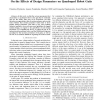Free Online Productivity Tools
i2Speak
i2Symbol
i2OCR
iTex2Img
iWeb2Print
iWeb2Shot
i2Type
iPdf2Split
iPdf2Merge
i2Bopomofo
i2Arabic
i2Style
i2Image
i2PDF
iLatex2Rtf
Sci2ools
ROBIO
2015
IEEE
2015
IEEE
On the effects of design parameters on quadruped robot gaits
—In this work, we link the various parameters that characterize a quadruped robot to the gait that it eventually opts for the steady state part of its locomotion. We then introduce an appropriate class of motion patterns, and provide some evidence that certain parameter values tend to favor specific pattern subclasses. This offers a new robot walking behavior qualitative view and some novel guidelines for legged systems design, in regard to the gait-effects of each design parameter. To accomplish the above, we adopt the use of an underactuated quadruped robot, and the Hildebrand diagrams paradigm for the succinct portraiture of its gaits, as well as the use of two distinct definitions regarding the motion stride.
ROBIO 2015 | Robotics |
| Added | 17 Apr 2016 |
| Updated | 17 Apr 2016 |
| Type | Journal |
| Year | 2015 |
| Where | ROBIO |
| Authors | Dimitrios Myrisiotis, Ioannis Poulakakis, Evangelos Papadopoulos |
Comments (0)

